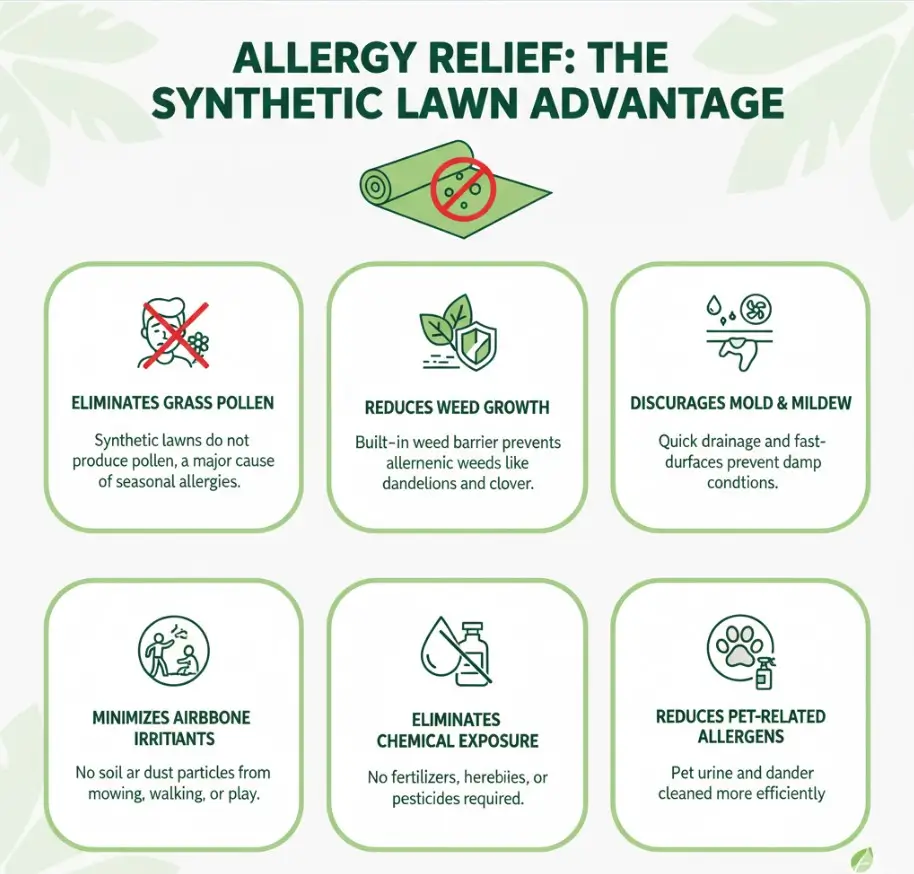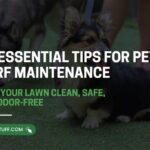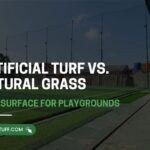Spending time in the yard should be relaxing, but for allergy sufferers, it can be anything but. Pollen, dust, and grass can trigger:
- Sneezing
- Itchy eyes
- Congestion
Artificial turf provides a simple solution. It delivers a lush, green lawn year-round while reducing exposure to common allergens.
Consider artificial turf if you want:
- Fewer allergy triggers.
- A low-maintenance yard.
- A safe, enjoyable space for family and pets.
This guide explains how switching to artificial turf can enhance your outdoor experience and help reduce seasonal allergy symptoms.
Table of Contents
Why Natural Grass Can Worsen Allergies
A natural grass lawn can trigger allergies, even though it looks beautiful. Grass produces pollen, which can cause:
- Sneezing
- Itchy eyes
- Congestion
Other factors that worsen allergies include:
- Mold and mildew in damp areas.
- Dust and soil particles kicked up during play or mowing.
- Weeds that release additional pollen
For allergy sufferers, these elements can make spending time outdoors uncomfortable. Switching to artificial turf reduces exposure to these triggers, creating a cleaner, allergy-friendly yard.
Which Grass Types Cause Allergy Symptoms?
Certain types of grass are more likely to trigger allergic reactions in people. Pollen from these grasses can cause sneezing, itchy eyes, congestion, and other allergy symptoms.
The most common allergenic grasses include:
- Bermuda grass – often used in warm climates and sports fields
- Ryegrass – popular for lawns and pastures
- Timothy grass – commonly found in hay and meadows
- Fescue – widely used in residential lawns
- Kentucky bluegrass – a favorite for lush, green lawns in cooler climates
If you are sensitive to grass pollen, these varieties can worsen symptoms and make outdoor time uncomfortable. Artificial turf removes these allergens, providing a green, low-maintenance lawn that’s easier to enjoy.
How Artificial Grass Helps Reduce Allergies (And What It Can’t Do)
How artificial grass can help reduce allergies
Artificial turf lowers exposure to several common allergens, making it a practical choice for allergy sufferers:
- Eliminates grass pollen – Synthetic lawns do not produce pollen, which is a major cause of seasonal allergies such as sneezing, itchy eyes, and nasal congestion.
- Reduces weed growth – Many artificial turf installations include a built-in weed barrier that prevents allergenic weeds like dandelions, clover, and crabgrass from growing.
- Discourages mold and mildew – Quick drainage and fast-drying surfaces prevent damp conditions where mold and mildew develop.
- Minimizes airborne irritants – Soil and dust particles that become airborne during mowing, walking, or play on natural grass are largely removed.
- Eliminates chemical exposure – Synthetic turf does not require fertilizers, herbicides, or pesticides, which can trigger allergic reactions or respiratory irritation.
- Reduces pet-related allergens – Pet urine and dander can be cleaned from artificial turf more efficiently, limiting allergen buildup.

What artificial grass cannot do (and its limitations)
Artificial turf lowers many allergy risks, but it is not a complete solution:
- Does not stop airborne pollen from other sources – Pollen from trees, shrubs, flowers, or neighboring lawns can still trigger allergic reactions.
- Can collect dust, pet dander, and debris – Leaves, dirt, and pet hair may accumulate on the surface and require regular cleaning.
- May trigger material sensitivities – Some people may react to synthetic fibers or infill materials used in turf.
- Does not eliminate bacteria or germs – Without routine cleaning, bacteria from pets, food, or outdoor contaminants remain on the surface.
- May cause skin irritation – Prolonged contact, especially in children or individuals with sensitive skin, can cause redness or itching.
- Requires maintenance for effectiveness – Rinsing, brushing, and sanitation are necessary to maintain hygiene and reduce allergens.
Artificial grass creates a controlled outdoor environment that lowers exposure to pollen, weeds, and soil-based irritants. With consistent cleaning and upkeep, it provides a safe, allergy-friendly lawn without the common challenges of natural grass.
Will Hypoallergenic Artificial Turf Help My Dog’s Allergies?
Hypoallergenic artificial turf can help reduce allergy triggers for dogs, though results depend on your pet’s sensitivities.
Benefits:
- Reduces pollen exposure, limiting sneezing and itchy skin.
- Fewer allergenic weeds.
- Quick-draining surfaces prevent mold and mildew.
- Easy to clean urine, hair, and dander.
Limitations:
- Pollen from nearby plants can still affect dogs.
- Dust, dirt, and pet dander can accumulate without cleaning.
- Some dogs may react to synthetic fibers or infill.
Regular cleaning keeps the turf allergy-friendly, making it a safer, more comfortable outdoor space for dogs.
How to Maintain an Allergy-Friendly Artificial Lawn
Artificial turf reduces many allergens, but regular maintenance is essential to keep it safe, clean, and comfortable. Follow these steps to protect against pollen, dust, pet dander, and other irritants:
- Remove debris regularly – Pick up leaves, sticks, and other debris that can accumulate on the surface. This prevents mold and allergens from building up.
- Rinse frequently – Use a hose to rinse the turf, especially in areas where pets play. This removes urine, dirt, and dust.
- Brush the turf – Use a stiff broom or a specialized turf brush to lift fibers, prevent matting, and keep the surface even.
- Sanitize periodically – Apply a pet-safe disinfectant or turf cleaner to reduce bacteria and germs. Focus on high-traffic areas and spots where pets spend the most time.
- Inspect for damage – Check seams, infill, and drainage regularly to ensure the turf remains functional and free from water pooling, which can encourage mold.
- Prevent accumulation of dust and pollen – Lightly hose the lawn after windy days or periods of high pollen to wash away allergens.
- Manage pet activity – Train pets to use designated areas for waste, then rinse and sanitize these spots to reduce odor and allergen buildup.
Consistent maintenance ensures the artificial lawn stays clean, allergy-friendly, and safe for both people and pets. A properly maintained turf lawn can provide a healthy outdoor space year-round without the common triggers found in natural grass.
Final Thoughts: A Healthier, Allergy-Friendly Lawn
Artificial grass is a practical choice for allergy sufferers, pets, and families seeking a clean, low-maintenance yard. It reduces exposure to pollen, weeds, mold, and chemicals while providing a green, durable lawn year-round.
While it does not remove all allergens, proper installation and regular maintenance make it an effective solution. Routine rinsing, brushing, and occasional sanitizing keep the lawn safe and comfortable for everyone, both two-legged and four-legged.
Choosing hypoallergenic artificial turf is more than a landscaping decision; it is an investment in health, comfort, and a relaxing, allergy-friendly outdoor space.
FAQ: Artificial Grass & Allergies
Yes. High-quality artificial turf is non-toxic and designed to withstand pet activity. It provides a durable, clean surface for dogs to play on.
Yes. It eliminates grass pollen and limits weed contact, reducing allergy triggers. Regular cleaning ensures the lawn remains safe and comfortable.
Puppies may dig or chew, but most high-quality turf is designed to withstand moderate chewing and digging. Training and monitoring can minimize damage.
Artificial turf reduces water use and eliminates chemical fertilizers and pesticides. However, it is made from synthetic materials, so recycling at the end of its lifespan should be considered.







